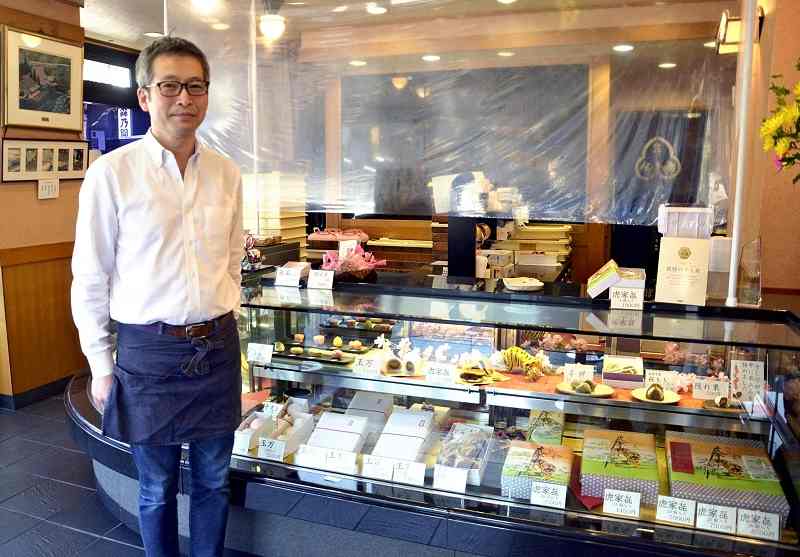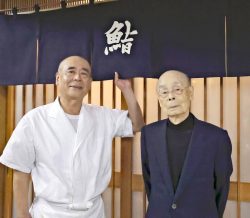
Gyokueido proprietor Yasuto Imae stands in his Japanese-style confectionery store in Nihombashi-Ningyocho in Chuo Ward, Tokyo, on Feb. 19. The shop sells amazake using a recipe it inherited from Owariya.
16:59 JST, March 30, 2021
Nihombashi-Ningyocho in Chuo Ward, Tokyo, was once a thriving nightlife district that was home to a collection of traditional Japanese restaurants where geisha gathered to entertain guests during meals and banquets.
Just off Ningyocho-dori — the central avenue in the district — stretches a small lane called Amazake Yokocho, which literally means “sweet sake alley.”
The alley is named after a sweet drink made from fermented rice that, despite its name, is virtually nonalcoholic. The beverage’s sweet scent wafts from the shops lining the lane.
I wondered about the origin of such a name and decided to take a stroll in this charming alley to learn more.

The amazake shop Owariya stands on the corner of Amazake Yokocho, an alley in Nihombashi-Ningyocho, in this photo taken in the 1930s.
Showa spirit
As I walked along the main avenue lined with various stores such as one selling ningyoyaki — a light sponge cake filled with sweet red bean paste — and a butcher’s shop, an emerald green banner caught my eye.
“Shitamachi promenade Amazake Yokocho” it read, with shitamachi being the low-lying area of eastern Tokyo near Tokyo Bay.
As if drawn in by the lettering, I turned the corner and entered an alley lined on both sides with many little shops. One was selling taiyaki — a fish-shaped pancake filled with sweet red bean paste — and another had tofu products on offer.
This is Amazake Yokocho, which spans about 400 meters and leads to the Meijiza theater.
“There once stood an amazake shop called Owariya at the entrance of the alley,” said Seiji Sasaki, explaining the origin of the back street’s name. Sasaki, 72, was born and raised in the area and is the head of the Amazake Yokocho business association.
From the Meiji era (1868-1912) to the early Showa era (1926-89), throngs of people came to this alley, the heart of which was the Owariya amazake shop.
According to Sasaki, the alley back then was situated just south of the present location and was much narrower. The back street was moved to the present location and widened as a result of the town’s rezoning as part of the area’s post-quake reconstruction in the wake of the Great Kanto Earthquake of 1923.
Along with old shops such as a long-established bamboo ware store, new ones have popped up, including a fashionable pizzeria. The historic alley has evolved into a shopping street with a colorful array of stores.
“I sometimes passed geisha on my way home from school and heard the sounds made by the ironware in which taiyaki is baked,” said Joji Yamada, 57, who was born in the neighborhood and is the proprietor of restaurant-bar Ballade.
Yamada nostalgically recalled the Amazake Yokocho of the Showa era. “Back then, the alley was richly imbued with the atmosphere of that period,” he said.
According to Yamada, who has been doing research on the history of Ningyocho for over 30 years, Owariya was thrived until the early Showa era. Many people got off the tram that used to run on present-day Ningyocho-dori and walked past the amazake shop on their way to Suitengu shrine, where many go to pray for safe childbirth.
Rebirth
Owariya closed down in the 1950s, much to the regret of those in the neighborhood.
Amazake Yokocho had lost its symbol, and instead came to be called “Meijiza-dori.”
However, people wondered if it was right to let the flame of the history of this alley and its long-cherished name be extinguished.
Many local residents resisted this, and momentum grew for reviving the Amazake Yokocho name.
In 1982, signboards and banners that conveyed the origin of the alley’s name were set up, and an organization — the predecessor of the current Amazake Yokocho business association — was founded.
From 1983 onward, an event held every March has been organized to distribute free cups of amazake, and the circle of people working to revitalize the district began to widen.
About 10 years ago, the area was used as a location in a TV drama set in Ningyocho, and the name Amazake Yokocho became known across the entire country. Sasaki, the local business association head, said shops selling the drink popped up around that time.
“Being Amazake Yokocho, we have to serve amazake,” Sasaki said.
Passing the torch
However, one shop in the alley has been selling amazake for decades: Gyukueido, a Japanese-style confectionery that operates at the former site of Owariya.
“I clearly remember hearing both my father and grandfather say, ‘Owariya strongly wished that amazake wouldn’t die out’” in Amazake Yokocho, said Yasuto Imae, 54, the proprietor of Gyokueido.
Before Owariya shut down, the owners stipulated one specific condition to the many merchants who sought to open a shop at the site with such a favorable location and plenty of pedestrian traffic: “Sell amazake.”
Owariya selected Gyokueido and passed down its amazake recipe.
Speculating on the origin of the alley’s name, Imai said, “People in the neighborhood would often use the amazake shop on the corner as a landmark when sending employees out to run errands.”
Requests to “go to the alley with the amazake shop on the corner” imperceptibly became connected with the Amazake Yokocho name, Imae said.
“I want to protect the alley’s name, which has been cherished from long ago, and the taste of the amazake that was inherited from Owariya,” he said.
Related Tags
"Features" POPULAR ARTICLE
-

Sanrio to Open Museum in Yamanashi Pref. Dedicated to Founder, Exhibits Include Hello Kitty, Other Characters
-

Legendary Sushi Chef Jiro Ono Turns 100: ‘I Have No Regrets’
-

Autumn Foliage Surrounds Visitors to Tokyo’s Showa Kinen Park
-

My Daughter No Longer Speaks to Me, But I Want to See Her and My Grandchild
-

Kumamoto: Public Bath Refurbished as Library Where You Can Chat, Take Photos
JN ACCESS RANKING
-

Keidanren Chairman Yoshinobu Tsutsui Visits Kashiwazaki-Kariwa Nuclear Power Plant; Inspects New Emergency Safety System
-

Imports of Rare Earths from China Facing Delays, May Be Caused by Deterioration of Japan-China Relations
-

University of Tokyo Professor Discusses Japanese Economic Security in Interview Ahead of Forum
-

Japan Pulls out of Vietnam Nuclear Project, Complicating Hanoi’s Power Plans
-

Govt Aims to Expand NISA Program Lineup, Abolish Age Restriction

























